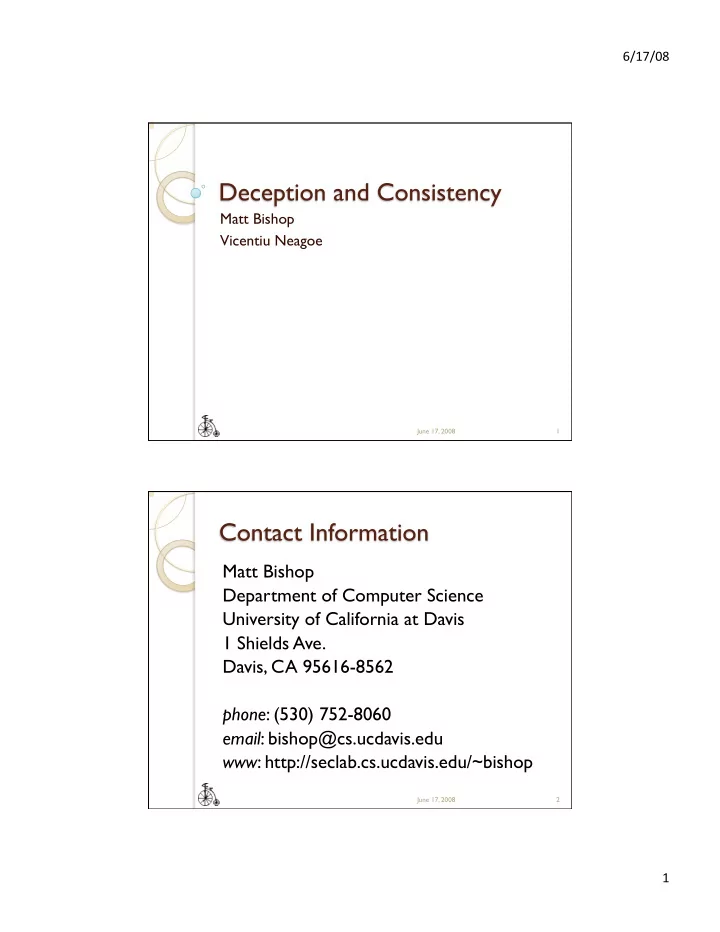

6/17/08 Matt Bishop Vicentiu Neagoe June 17, 2008 1 Matt Bishop Department of Computer Science University of California at Davis 1 Shields Ave. Davis, CA 95616-8562 phone : (530) 752-8060 email : bishop@cs.ucdavis.edu www : http://seclab.cs.ucdavis.edu/~bishop June 17, 2008 2 1
6/17/08 Create confusion in attacker ◦ Induce delay in decision making Waste their time Make them go away on their own Distract them towards a different path ◦ Stir up curiosity about bizarre behavior Blur the line between what is allowed and what is not allowed Trigger alerts and heavy analysis June 17, 2008 3 Previous work assumed consistency is critical to successful defense ◦ Attacker gains the advantage is deception is detected ◦ Inconsistency will expose presence of deception So what? ◦ If attacker knows deception is used, they still must distinguish between what is deceptive and what is real June 17, 2008 4 2
6/17/08 Inconsistent deception easier to implement than consistent deception ◦ Use regular deception techniques but don’t worry about consistency Make the system behave unpredictably ◦ May be malfunctioning ◦ Undergoing modification ◦ Defense response June 17, 2008 5 Performed Response Verify Response Verify response Consistent Action truthfulness truthfulness No Deleted False File exists True No No Deleted False File gone False Yes No Not Deleted True File exists True Yes No Not Deleted True File gone False No Yes Not Deleted False File exists False Yes Yes Not Deleted False File gone True No Yes Deleted True File exists False No Yes Deleted True File gone True Yes consistent real system deception June 17, 2008 6 3
6/17/08 User Kernel sys_read() Program System Call Table /dev/kmem Current directory info sys_getcwd() pwd /proc d_path() sys_getdents() June 17, 2008 7 Vertical – separate paths return different answers Horizontal – same path returns different answer June 17, 2008 8 4
6/17/08 Process needs to determine its current working directory ◦ Relative path names interpreted with respect to that directory ◦ Is current working directory the real one or one created as part of a deception? In the latter case, the system wants to lie about the name June 17, 2008 9 Kernel User sys_read() Program System Call Table /dev/kmem Current directory info sys_getcwd() pwd /proc d_path() sys_getdents() June 17, 2008 10 5
6/17/08 User Kernel sys_read() Program System Call Table /dev/kmem Current directory info sys_getcwd() pwd /proc d_path() sys_getdents() June 17, 2008 11 Inconsistency does not mean deception ◦ System could be flaky or malfunctioning If attacker believes deception is being used, may try to evaluate sources ◦ The richer semantically a component is, the harder to make it appear consistent Many types of inconsistency ◦ Data: results vary ◦ Semantics: expression of results vary June 17, 2008 12 6
6/17/08 Given a file that an attacker wants access to, determine paths through kernel that can be used to obtain information or access ◦ Establish methodology to do this Add horizontal, vertical deception Evaluate how attacker can “break” this ◦ How can attacker determine deception is being used? ◦ How can attacker distinguish non-deceptive responses from deceptive responses? June 17, 2008 13 V. Neagoe and M. Bishop, “Inconsistency in Deception for Defense,” Proceedings of the New Security Paradigms Workshop pp. 31–38 (Sep. 2006). D. Rogers, Host-level Deception as a Defense against Insiders , M.S. Thesis (2004) June 17, 2008 14 7
Recommend
More recommend